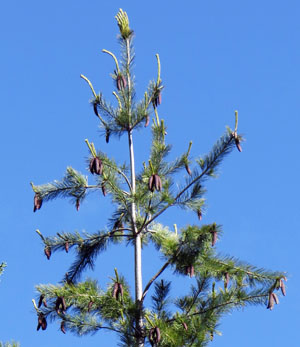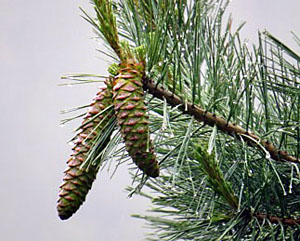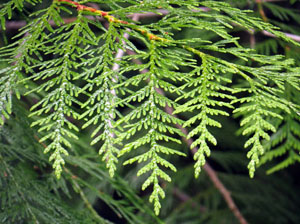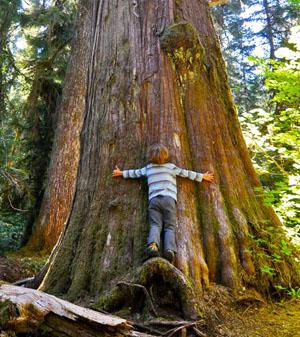| HOME | PROTECTION | NATURE | PLAN YOUR VISIT | FAQ | JOIN/DONATE | ABOUT |
| Conifers in the proposed Douglas-Fir National Monument |
| For more about trees in the proposed monument, go to Wandering Among the Trees of the Doug. |
We’re calling it Douglas-Fir National Monument because that is the dominant tree in the forest. But there are numerous other conifers (generally evergreen, cone-bearing trees with needles) in our woods. |
|
|
Western White Pine (Pinus monticola) |
|
This pine is found in our mountains at elevations of 4000 feet and above. It grows in mixed stands along with Douglas-fir, western hemlock, and Pacific silver fir. Identifying features: Form: A straight-trunked tree that can reach more than 100 feet in height and occasionally grows to 3 feet in diameter. Branches in the upper crown arch upwards. Bark: On young trees it is grey and smooth with resin blisters. On older trees it is dark grey and broken into distinctive rectangular blocks. It may become as thick as 1 1⁄2 inches. Leaves: Needles are 5 in a bundle, 2 to 4 inches long, slender, blue-green in color. Cones: Mature cones are 5 to 12 inches long, cylindrical, curved, with thin scales and not armed with a prickle. They can be seen dangling from branch tips. This tree produces many cones, which can often be found on the ground when they have matured. Importance: In some parts of Northwest North America where the tree occurs more commonly, it is very valuable for the high-quality wood (lumber) it produces. At our location, it is a naturally-occurring component of our mountain forests. |
  |
Western Redcedar (Thuja plicata) |
|
This tree is commonly found in Douglas-fir and western hemlock forests in the Pacific Northwest. It is shade-tolerant and prefers moist habitats. Identifying features: Form: Western redcedar can grow to more than 100 feet in height and 4 feet in diameter. Trees often have swollen and fluted trunks. Branches are dense and foliage is thick and drooping. Bark: Thin, reddish-brown, ridged and furrowed. Northwest Indians used the inner bark to make blankets, clothing, rope, nets, and baskets. Leaves: Needles are scale-like, less than 1⁄4 inch long, and appressed (lay flat) to the twigs. Green above with a white “butterfly” pattern below. The foliage is aromatic when crushed in the fingers. Cones: Small (1⁄2 inch long) and woody, shaped like rose buds. They grow upright on the twigs and mature in one season. Importance: This was perhaps the most useful tree to the Indians of our area. From its wood they made sea-faring canoes, shelters, and carved totem poles. The wood is very durable and is used for roof shingles and siding today. Here in the forest it helps stabilize the soil along creek banks and grows along with western hemlock in the understory. |
  |
Pacific Silver Fir (Abies amabilis) |
|
This true fir is native in our mountains at elevations of 4000 feet and above. It grows in mixed stands along with Douglas-fir, western hemlock, and western white pine. Identifying features: Form: A tall, straight tree that often reaches 100 feet or more in height and 3 feet in diameter. The crown of the tree is long and conical in shape. Bark: On young trees smooth and silvery-grey in color, and covered with many resin blisters. On larger trees the bark becomes grey and scaly and one may see large chalky-white areas on the trunk. Leaves: The needles are linear, flat, grooved on the upper surface, notched at the tip, 1 inch or a bit longer, green above with a silvery-white underside. They are clustered on the upper side of the branch and often point upwards. Cones: Stand erect on upper branches, 3 to 6 inches long, barrel-shaped, purple in color with globules of pitch on the surface. They mature in one season then while still in the crown of the tree they fall apart (and wind scatters the seeds). Rarely do you find an intact cone on the ground. Importance: The wood of this tree is sawn into lumber and is of good quality and widely used. At our location these trees are an important component of our mountain forests. |
|
Noble fir (Abies procera) |
|
This is one of two true fir species that grow in our mountains at elevations of 4000 feet and above. It is found in mixed stands along with Douglas-fir, western white pine and Pacific silver fir. Form: Noble fir lives up to its name being a tall, straight tree reaching 100 feet or more in height and 3 feet in diameter. The crown is long and tapering. The short, stiff branches and pointed tops shed snow without breaking. Bark: Smooth, grey-brown in color with many resin blisters on young trees. As trees mature the bark becomes reddish-brown, thicker, and forms flattened ridges. Foliage: The needles are very stiff, about 1 inch in length, and shaped like a hockey stick. On the upper side there is a groove. They grow densely on the upper side of the twigs. A distinctive feature is their white color on both surfaces. This color gives the tree a unique appearance – silvery-white when seen at a distance. Cones: Upright on upper branches and up to 6 inches long and 3 inches thick, light brown in color. These cylindrical-shaped cones have very distinctive, showy bracts that extend outward past the cone’s scales. These bracts are bent downwards and almost completely cover the cone scales. This feature is not found on Pacific silver fir. At maturity the cones fall apart while still on the tree and wind scatters the seeds. Rarely is an intact cone found on the ground unless a squirrel has cut it from a high branch so it can get to the edible seeds. Importance: This tree is adapted to higher elevations in our mountains and is an important component of the forests. Wood from the tree is sawn into high- quality lumber. Noble fir is widely grown for Christmas trees. |
|
These are some of the conifers you are likely to find on your travels through the proposed Douglas-fir National Monument. You also might find: • Sugar Pine • Pacific Yew • Lodgepole Pine • Grand Fir • Engelmann Spruce • Subalpine Fir • Ponderosa Pine • Alaska Yellow Cedar. To learn more about all these trees and more, check out TREES TO KNOW IN OREGON available from the OSU Extension Service: https://catalog.extension.oregonstate.edu/ec1450. |
| For more about trees in the proposed monument, go to Wandering Among the Trees of the Doug. |
| Return to Nature |